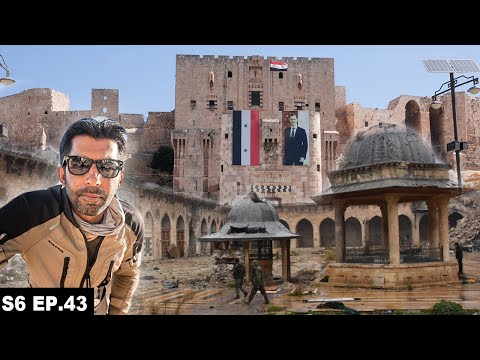LIFE IN ALEPPO Heart Breaking S06 EP.43 | MIDDLE EAST MOTORCYCLE TOUR

But the majority of it is ruined. The scale of destruction suggests an overly excessive use of dynamite. There used to be a rather beautiful mosque from the Ottoman times.
It has been wiped from the face of the earth. Neither the minaret ... nor the mosque exists anymore. You can see all the rubble here. Assalam Alekum Everyone and Welcome Back to the Channel from Aleppo. Or ... Halab, as they call it in Arabic. Halab is the name that appears in the historical records of this city.
I tried to give you an overview of this city in the previous vlog. But I didn't go into too much detail. That we'll do today. We'll explore all the worth visiting places here, together.
Aleppo is an 8000 years old city. Like Damascus, it's one of the most ancient cities of the world. And it has been continuously inhabited ever since. Although Jericho in Palestine is considered to be the oldest city of the world. But there have been times, when nobody lived there.
However, that's not the case here. There are still a number of historical places to visit. I think it would be a great shock for people who have already visited Aleppo before the war... to see it in its present condition.
I'll try my best to share this experience with you... especially the old town. Right now we are at Al-Jabri Square which is the center of Aleppo. The hotel in sight is where I'm staying. It's called Halab Qasr Palace or Aleppo Palace. The devastated building right next to it also used to be a hotel. It has suffered car bomb blasts twice.
Currently it's closed due to its present condition. Restoration work is in progress. It's one of numerous other such buildings here. I'll share the important ones with you.
You'll see a lot of historical buildings in the old town. Many of them have traditionally built hotels. One of them, which is considered to be the face of Aleppo, is Baron Hotel. This is the place where presidents of countries, actors and other famous personalities would stay.
The movie 'Lawrence of Arabia' was filmed here. You name any president who visited the city... and he must have stayed in this hotel. It has been abandoned since the war.
The owners are still staying here but there are no guests. Built in 1911 in the Armenian style of construction. Because many Armenians migrated from Turkey and settled here. They also brought their culture and history with them. That's why you'll find many buildings here with Armenian architecture.
Let's get in and see it from the inside. We are in the hotel bar now. In case you are wondering...alcohol in a Muslim country like Syria?? The Syrian law does not prohibit that. You can find alcohol in almost every hotel. Also you can easily find it in any supermarket or kiosk as it is legal.
Unless someone doesn't want to sell it. This part of the city was famous among the tourists. They won't all take a room here.
They would just visit the place to experience the atmosphere. They would sit here and sip on their tea, coffee or whatever... They also had a restaurant next to it. You can see cracks on the walls and that the plaster has come off.
There have been many blasts on the road and you can see its effects here as well. The owners are trying to resume their business and so they have prepared few rooms already. Hopefully, in a few years, you will see the hotel back in business.
Let's sit here for some time and enjoy our coffee. You are now looking at the road that connects the old town with the new town. You will also see the parts of the city wall here.
It is more visible in the area next to this one. Here there are many shops, so the wall is not clearly visible. I'll show you the place where it can be seen. I'm standing at one of the gates of old city; Bab Antakya. The city has a total of 8 gates.
They are still in a good condition and we'll visit them shortly. Bab Antakya is named so as it faces Antakya which is a city in present day Turkey. Antakya lies on the Mediterranean. The building dates back to the Roman times. Its restoration work was done by Prince Zahir Ghazi; the son of Saladin.
He signed some contracts with European traders to facilitate the cotton and silk trade through Syria to Europe. In exchange the traders would bring wool here. Let's go in and see the old city. Aleppo souq is among the biggest souqs in the world. It spans over a length of 7 km.
It's even bigger than the souq in Istanbul. You'll see a lot of garments here and they are all made in Aleppo. The reason being the highly fertile land of Aleppo.
Secondly, heavy rains make the local cotton, one of the best in the world. The textile industry in Aleppo used to export finished cotton products through the Arab world, before the war. You could also find Aleppo garments abundantly in different parts of Europe. According to our guide, the jerseys of 2002 Football World Cup were made in Aleppo.
Another reason is that the Aleppo traders were rather well known. During Ottoman times, Aleppo was the second biggest trade city after Istanbul. Today, it has been renovated at some points. I'll show you the condition of the next souq, shortly. However, parts of the souq near Bab Antakya have been restored. The main part of old bazaars or souqs around the world is the caravan saraye (inn).
Traders from all around the world, who would come here for business, would stay here. Aleppo has more than 30 caravan inns. Right now I'm standing at Al-Jumruk.
This was the largest inn with rooms for 372 traders. Besides, it also had Dutch, English and French Consulates. There were banks as well in order to pay taxes.
Currently, few shops have been opened here while others are being renovated. A major part of the souq has been destroyed. Not just the roof and walls but everything that you can see is a wreck. It's nearly impossible for me to express the scenes that I'm witnessing here, in words. Many narrow streets would emerge from the souq but all of that has suffered destruction.
A very small portion has been opened after restoration. But majority of it is just gone. The scale of this destruction suggests an excessively excessive use of dynamite. According to our guide, trenches were dug underground and filled with dynamite to blow up the whole thing.
That's when the rebels were leaving after getting defeated. They made sure to destroy everything before they left. We met some locals who were sitting towards the end of the souq.
They had their shops here. We talked to them and they showed us how amazing this place used to be, before the war. Looking at the images before and after the war...
Makes you wonder... what a decade of destruction can do to a place. People here are very nice. The guy took me along and showed me the mosque.
The old mosque is really beautiful and is still in good condition. The locals are just waiting for restorations so that the souq will come back to life once again. Back to life... Once more... After visiting the souq, we've come to the citadel. The highest historical building in the middle of town.
The citadel is almost 4000 years old. As I told you that the Umayyad mosque was built over the Hadad temple. Similarly, there used to be a temple of Hadad here as well. Later, the temple was transformed to an army garrison by the Greeks when they came here. The current building was constructed by Sultan Zahir Ghazi. The current form of this citadel... the gate... the
stairs for entrance... the arches... All of it dates back to the time of Sultan Zahir Ghazi who was the son of Sultan Saladin. Other than that, the trench you can see was filled by water. Next to that, a slope was created by stones, to prevent any invaders to climb up to reach the citadel. I'm not sure what we are gonna see inside... But lets get in anyway... Hopefully, we'll get a great view of the city.
The citadel has 3 gates. As soon as you enter, you immediately notice a grand and massive construction wonder. It's comprised of dark tunnels and alleys...
With rooms on each side for the army to ensure a sound defense of the citadel. You will see some round shaped stones here. They were meant to be thrown at any invading army. After crossing the second gate, a little before the third gate...
almost right next to it, there is a spot called Maqam e Khizar (AS). It is believed that Khizar (AS) visited this place. It's not a grave or a shrine... Just a spot to mark his visit. Just as you cross the third gate, you see many shops.
There used to be a whole souq inside the citadel. Other than that, there was a bath as well as Maqam e Ibrahim (AS). I'll share more about that and show you the place if we get the permission to get in.
You are now looking at the theater that was built here, later. Before the war, there used to be an annual festival in Aleppo, here at this place. And if you look beyond that, you will see this building... This was the bath house.
Right next to the bath, behind these trees, there was a little palace for Sultan Zahir Ghazi. The trees have covered the view as it's a rather small palace. Towards the end of the citadel, you'll notice a tower. It's actually the minaret of a mosque that was built by Sultan, in the final years of the 12th century. It's a small but beautiful mosque... although not functional today...
But it's open for visits. You can see that the top of the minaret has been destroyed in war. It is believed that the Prophet Abraham (pbuh) used to live at the top of this hill. And he had a number of cows. He would distribute the milk of his cows among the people of this area.
The process of milking a cow is called Halab in Arabic. That's how the city got its name. The most beautiful building of the citadel is built on its wall. It was called the Reception Hall as Sultan would receive foreign delegation in this hall. Its ceiling fell down during one of the earthquakes in Aleppo. It was renovated later in the way that is specific to Aleppo.
Just look how beautiful the wood work on the ceiling is. Sadly, the top of the citadel will give you an unfortunate view like this. The darkened building that you see was the courthouse that has been destroyed. Next to it are the bath houses from the Mamluk times and are destroyed too.
Adjacent to that were buildings from Ottoman times, which had been transformed into police station. Those were some great looking buildings but nothing is left of them today. The small minaret beside used to house the graves of Sultan Zahir Ghazi and his wife. There was also a madrassa next to it that now shares the same fate.
You can notice a small hill in the background that has nothing to see today. There used to be a very beautiful Ottoman mosque there... But the destruction has wiped it off the face of the earth. You can now see the neighboring area of the citadel that we saw from the top.
You can see the final resting place of Sultan Zahir and his wife. And also the madrassa. It won't be wrong if I say that I'm standing at the most significant historical site in Aleppo. Because this is one of the oldest mosques in the world.
It's called the Umayyad mosque. Built around the same time when Waleed Al-Malik built the mosque in Damascus. The style of construction is also the same. An interesting thing about this mosque was its 45 m tall minaret. It was built at a later stage during the Seljuk times.
It was considered to be a very unique minaret with no parallel in the world. It was a UNESCO World Heritage site. It was one of its own kind. Neither the minarets ... nor the mosque exist anymore.
All you can see here is the rubble. We can't go inside the mosque due to restoration work. However, recording from the outside is not prohibited. Much like the mosque, the surrounding area is adversely affected. All you see are demolished or burnt buildings.
The whole place is in ruins. It's 9 pm. Almost 70-80 shops are already closed. The ones that are still open may get closed in the next hour or so.
The shopkeepers would also like to close and go home. Because it's really expensive to afford electricity here. Those who can't afford it, just close their shops as soon as it gets dark. Before the war, Aleppo used to be a city that never slept.
Such a lively place to be... Sadly, it turns into a ghost town as soon as it gets dark. I've tried my best to show you Aleppo with historical context. I've tried to share the maximum information with you.
I hope you must have enjoyed that. Unfortunately the situation of this city is not very promising. Let's pray for this city to return to its past glory. Lets pray that it may get reconstructed in a way that we get to see the same Aleppo that once was. Remember me in your prayers. Don't forget to Like, Subscribe and Share. Allah Hafiz
2022-09-27 06:21


